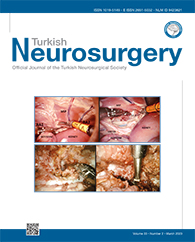Turkish Neurosurgery
2023 , Vol 33 , Num 2
1Gulhane Education and Research Hospital, Department of Infectious Diseases, Ankara, Turkey
2Gulhane Education and Reseach Hospital, Department of Neurosurgery, Ankara, Turkey DOI : 10.5137/1019-5149.JTN.40387-22.4 Anahtar Kelimeler :
İletişim Kurulacak Yazar : Gulden YILMAZ TEHLI, drguldeny@yahoo.com.tr
2Gulhane Education and Reseach Hospital, Department of Neurosurgery, Ankara, Turkey DOI : 10.5137/1019-5149.JTN.40387-22.4 Anahtar Kelimeler :





